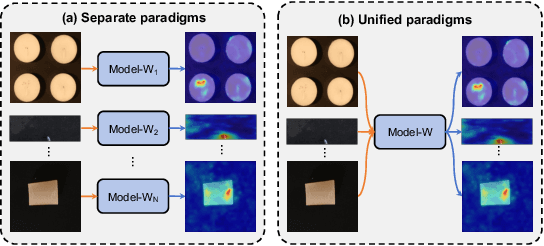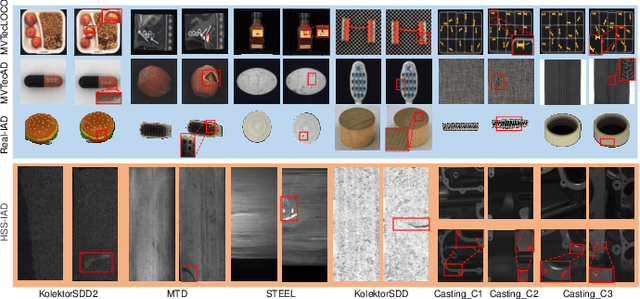Junjie Hu
Fudan university
PETAR: Localized Findings Generation with Mask-Aware Vision-Language Modeling for PET Automated Reporting
Oct 31, 2025Abstract:Recent advances in vision-language models (VLMs) have enabled impressive multimodal reasoning, yet most medical applications remain limited to 2D imaging. In this work, we extend VLMs to 3D positron emission tomography and computed tomography (PET/CT), a domain characterized by large volumetric data, small and dispersed lesions, and lengthy radiology reports. We introduce a large-scale dataset comprising over 11,000 lesion-level descriptions paired with 3D segmentations from more than 5,000 PET/CT exams, extracted via a hybrid rule-based and large language model (LLM) pipeline. Building upon this dataset, we propose PETAR-4B, a 3D mask-aware vision-language model that integrates PET, CT, and lesion contours for spatially grounded report generation. PETAR bridges global contextual reasoning with fine-grained lesion awareness, producing clinically coherent and localized findings. Comprehensive automated and human evaluations demonstrate that PETAR substantially improves PET/CT report generation quality, advancing 3D medical vision-language understanding.
V-SEAM: Visual Semantic Editing and Attention Modulating for Causal Interpretability of Vision-Language Models
Sep 18, 2025Abstract:Recent advances in causal interpretability have extended from language models to vision-language models (VLMs), seeking to reveal their internal mechanisms through input interventions. While textual interventions often target semantics, visual interventions typically rely on coarse pixel-level perturbations, limiting semantic insights on multimodal integration. In this study, we introduce V-SEAM, a novel framework that combines Visual Semantic Editing and Attention Modulating for causal interpretation of VLMs. V-SEAM enables concept-level visual manipulations and identifies attention heads with positive or negative contributions to predictions across three semantic levels: objects, attributes, and relationships. We observe that positive heads are often shared within the same semantic level but vary across levels, while negative heads tend to generalize broadly. Finally, we introduce an automatic method to modulate key head embeddings, demonstrating enhanced performance for both LLaVA and InstructBLIP across three diverse VQA benchmarks. Our data and code are released at: https://github.com/petergit1/V-SEAM.
LLM Hallucination Detection: A Fast Fourier Transform Method Based on Hidden Layer Temporal Signals
Sep 16, 2025



Abstract:Hallucination remains a critical barrier for deploying large language models (LLMs) in reliability-sensitive applications. Existing detection methods largely fall into two categories: factuality checking, which is fundamentally constrained by external knowledge coverage, and static hidden-state analysis, that fails to capture deviations in reasoning dynamics. As a result, their effectiveness and robustness remain limited. We propose HSAD (Hidden Signal Analysis-based Detection), a novel hallucination detection framework that models the temporal dynamics of hidden representations during autoregressive generation. HSAD constructs hidden-layer signals by sampling activations across layers, applies Fast Fourier Transform (FFT) to obtain frequency-domain representations, and extracts the strongest non-DC frequency component as spectral features. Furthermore, by leveraging the autoregressive nature of LLMs, HSAD identifies optimal observation points for effective and reliable detection. Across multiple benchmarks, including TruthfulQA, HSAD achieves over 10 percentage points improvement compared to prior state-of-the-art methods. By integrating reasoning-process modeling with frequency-domain analysis, HSAD establishes a new paradigm for robust hallucination detection in LLMs.
Exploiting Unlabeled Structures through Task Consistency Training for Versatile Medical Image Segmentation
Sep 05, 2025



Abstract:Versatile medical image segmentation (VMIS) targets the segmentation of multiple classes, while obtaining full annotations for all classes is often impractical due to the time and labor required. Leveraging partially labeled datasets (PLDs) presents a promising alternative; however, current VMIS approaches face significant class imbalance due to the unequal category distribution in PLDs. Existing methods attempt to address this by generating pseudo-full labels. Nevertheless, these typically require additional models and often result in potential performance degradation from label noise. In this work, we introduce a Task Consistency Training (TCT) framework to address class imbalance without requiring extra models. TCT includes a backbone network with a main segmentation head (MSH) for multi-channel predictions and multiple auxiliary task heads (ATHs) for task-specific predictions. By enforcing a consistency constraint between the MSH and ATH predictions, TCT effectively utilizes unlabeled anatomical structures. To avoid error propagation from low-consistency, potentially noisy data, we propose a filtering strategy to exclude such data. Additionally, we introduce a unified auxiliary uncertainty-weighted loss (UAUWL) to mitigate segmentation quality declines caused by the dominance of specific tasks. Extensive experiments on eight abdominal datasets from diverse clinical sites demonstrate our approach's effectiveness.
Scaling Up Audio-Synchronized Visual Animation: An Efficient Training Paradigm
Aug 05, 2025Abstract:Recent advances in audio-synchronized visual animation enable control of video content using audios from specific classes. However, existing methods rely heavily on expensive manual curation of high-quality, class-specific training videos, posing challenges to scaling up to diverse audio-video classes in the open world. In this work, we propose an efficient two-stage training paradigm to scale up audio-synchronized visual animation using abundant but noisy videos. In stage one, we automatically curate large-scale videos for pretraining, allowing the model to learn diverse but imperfect audio-video alignments. In stage two, we finetune the model on manually curated high-quality examples, but only at a small scale, significantly reducing the required human effort. We further enhance synchronization by allowing each frame to access rich audio context via multi-feature conditioning and window attention. To efficiently train the model, we leverage pretrained text-to-video generator and audio encoders, introducing only 1.9\% additional trainable parameters to learn audio-conditioning capability without compromising the generator's prior knowledge. For evaluation, we introduce AVSync48, a benchmark with videos from 48 classes, which is 3$\times$ more diverse than previous benchmarks. Extensive experiments show that our method significantly reduces reliance on manual curation by over 10$\times$, while generalizing to many open classes.
R-KV: Redundancy-aware KV Cache Compression for Training-Free Reasoning Models Acceleration
May 30, 2025Abstract:Reasoning models have demonstrated impressive performance in self-reflection and chain-of-thought reasoning. However, they often produce excessively long outputs, leading to prohibitively large key-value (KV) caches during inference. While chain-of-thought inference significantly improves performance on complex reasoning tasks, it can also lead to reasoning failures when deployed with existing KV cache compression approaches. To address this, we propose Redundancy-aware KV Cache Compression for Reasoning models (R-KV), a novel method specifically targeting redundant tokens in reasoning models. Our method preserves nearly 100% of the full KV cache performance using only 10% of the KV cache, substantially outperforming existing KV cache baselines, which reach only 60% of the performance. Remarkably, R-KV even achieves 105% of full KV cache performance with 16% of the KV cache. This KV-cache reduction also leads to a 90% memory saving and a 6.6X throughput over standard chain-of-thought reasoning inference. Experimental results show that R-KV consistently outperforms existing KV cache compression baselines across two mathematical reasoning datasets.
VisualToolAgent (VisTA): A Reinforcement Learning Framework for Visual Tool Selection
May 26, 2025Abstract:We introduce VisTA, a new reinforcement learning framework that empowers visual agents to dynamically explore, select, and combine tools from a diverse library based on empirical performance. Existing methods for tool-augmented reasoning either rely on training-free prompting or large-scale fine-tuning; both lack active tool exploration and typically assume limited tool diversity, and fine-tuning methods additionally demand extensive human supervision. In contrast, VisTA leverages end-to-end reinforcement learning to iteratively refine sophisticated, query-specific tool selection strategies, using task outcomes as feedback signals. Through Group Relative Policy Optimization (GRPO), our framework enables an agent to autonomously discover effective tool-selection pathways without requiring explicit reasoning supervision. Experiments on the ChartQA, Geometry3K, and BlindTest benchmarks demonstrate that VisTA achieves substantial performance gains over training-free baselines, especially on out-of-distribution examples. These results highlight VisTA's ability to enhance generalization, adaptively utilize diverse tools, and pave the way for flexible, experience-driven visual reasoning systems.
kFuse: A novel density based agglomerative clustering
May 09, 2025Abstract:Agglomerative clustering has emerged as a vital tool in data analysis due to its intuitive and flexible characteristics. However, existing agglomerative clustering methods often involve additional parameters for sub-cluster partitioning and inter-cluster similarity assessment. This necessitates different parameter settings across various datasets, which is undoubtedly challenging in the absence of prior knowledge. Moreover, existing agglomerative clustering techniques are constrained by the calculation method of connection distance, leading to unstable clustering results. To address these issues, this paper introduces a novel density-based agglomerative clustering method, termed kFuse. kFuse comprises four key components: (1) sub-cluster partitioning based on natural neighbors; (2) determination of boundary connectivity between sub-clusters through the computation of adjacent samples and shortest distances; (3) assessment of density similarity between sub-clusters via the calculation of mean density and variance; and (4) establishment of merging rules between sub-clusters based on boundary connectivity and density similarity. kFuse requires the specification of the number of clusters only at the final merging stage. Additionally, by comprehensively considering adjacent samples, distances, and densities among different sub-clusters, kFuse significantly enhances accuracy during the merging phase, thereby greatly improving its identification capability. Experimental results on both synthetic and real-world datasets validate the effectiveness of kFuse.
Future-Oriented Navigation: Dynamic Obstacle Avoidance with One-Shot Energy-Based Multimodal Motion Prediction
May 01, 2025Abstract:This paper proposes an integrated approach for the safe and efficient control of mobile robots in dynamic and uncertain environments. The approach consists of two key steps: one-shot multimodal motion prediction to anticipate motions of dynamic obstacles and model predictive control to incorporate these predictions into the motion planning process. Motion prediction is driven by an energy-based neural network that generates high-resolution, multi-step predictions in a single operation. The prediction outcomes are further utilized to create geometric shapes formulated as mathematical constraints. Instead of treating each dynamic obstacle individually, predicted obstacles are grouped by proximity in an unsupervised way to improve performance and efficiency. The overall collision-free navigation is handled by model predictive control with a specific design for proactive dynamic obstacle avoidance. The proposed approach allows mobile robots to navigate effectively in dynamic environments. Its performance is accessed across various scenarios that represent typical warehouse settings. The results demonstrate that the proposed approach outperforms other existing dynamic obstacle avoidance methods.
HSS-IAD: A Heterogeneous Same-Sort Industrial Anomaly Detection Dataset
Apr 17, 2025



Abstract:Multi-class Unsupervised Anomaly Detection algorithms (MUAD) are receiving increasing attention due to their relatively low deployment costs and improved training efficiency. However, the real-world effectiveness of MUAD methods is questioned due to limitations in current Industrial Anomaly Detection (IAD) datasets. These datasets contain numerous classes that are unlikely to be produced by the same factory and fail to cover multiple structures or appearances. Additionally, the defects do not reflect real-world characteristics. Therefore, we introduce the Heterogeneous Same-Sort Industrial Anomaly Detection (HSS-IAD) dataset, which contains 8,580 images of metallic-like industrial parts and precise anomaly annotations. These parts exhibit variations in structure and appearance, with subtle defects that closely resemble the base materials. We also provide foreground images for synthetic anomaly generation. Finally, we evaluate popular IAD methods on this dataset under multi-class and class-separated settings, demonstrating its potential to bridge the gap between existing datasets and real factory conditions. The dataset is available at https://github.com/Qiqigeww/HSS-IAD-Dataset.
 Add to Chrome
Add to Chrome Add to Firefox
Add to Firefox Add to Edge
Add to Edge